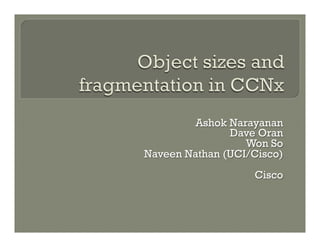
CCNxCon2012: Session 5: Object Sizes in Named Data Networking
- 1. Ashok Narayanan Dave Oran Won So Naveen Nathan (UCI/Cisco) Cisco
- 2. ! Applications define objects of arbitrary size ! Therefore, NDN needs to be able to cache and deliver objects of arbitrary size • The extreme case: a stream, which is infinite in size • More realistic: a maximum object size that will serve the vast majority of common applications ! This problem needs to be solved between: • The naming convention • The network protocol • The application
- 3. ! Natural link MTUs are small ! There’s a gap between natural MTU sizes and natural object sizes ! There are five options to bridge this gap 1. Applications must size object to network MTU 2. Rely on lower layer fragmentation & reassembly 3. Naming convention to identify fragments 4. Publisher-authored manifest to list fragments 5. In-network fragmentation within NDN ! The truth lies in some combination of these
- 4. ! What are “natural object sizes”? • Hard to tell, but some estimates exist… ! Web pages average: 16KB per page, 120KB for CSS/scripts etc ! Pictures average: 100KB per uploaded photo, 2MB per stored photo ! Video: 500KB-15MB per ABR video chunk ! Email: 75KB avg, 22KB-400KB spread ! Document per page: PDF 62KB, .DOC 25KB
- 5. ! Object-based formats cannot support an infinite object size • It’s basically a question of picking a maximum object size ! It’s unreasonable for applications to size objects to the smallest possible MTU • Applications don’t know which link the data will traverse ! Relying on underlying fragmentation is fragile • IP fragmentation suffers from packet loss amplification & reassembly delays (3x for CCNx) • Other lower layer transports may offer no fragmentation
- 6. ! CCNxcurrently relies on (2+3) – naming convention for 4KB objects, and lower layer fragmentation to carry these • Requires fragmentation features in lower layer • Architectural early binding to small but MTU- independent chunk size • Imposes restrictions on naming ! Manifest-based schemes slightly better (??) • Publisher selects private scheme for chunk naming • Object fetch retrieves a manifest of chunk names • Still requires MTU-independent fragment size
- 7. ! IfCCNx is truly to operate on any link layer, fragmentation needs to be built into the CCNx layer • Can’t rely on lower layer to support fragmentation • Can’t size fragments to MTU at publication ! Given that the CCNx layer can fragment and reassemble, how far should it go?
- 8. ! Publishers sign the complete object ! Any node can (re-)fragment at will ! Each fragment should be completely identifiable as part of its object ! Fragment cut-though forwarding without reassembly • Critical to remove latency penalty
- 9. Fragment-Info ContentSize Signature Signature FragmentOffset Name Name FragmentSize Signed-Info Signed-Info Key (Name) Data … Fragment-Info Data … Data … Fragment-Info … Data
- 10. ! Fragments match a pending interest • … but don’t satisfy it ! Node immediately forwards fragments towards matching PIT entry face(s) ! Node keeps track of fragment set in PIT • Consume entry once all fragments are forwarded ! End-hostconsumes reassembled object ! Cache delivers whole objects • Physical reassembly not actually required
- 11. ! Flow balance is changed • Significant issue for large objects • Requires a per-hop congestion control schemes which can handle variant object sizes • We believe an appropriate scheme exists ! Ack/Nack scheme required? • Optional if lower layer is reliable • Nack: Add a “subrange fetch” field to the Interest? • Reliability can be end-to-end or hop-by-hop • Degenerate solution: small objects, no repair
- 12. ! Individual fragments cannot be authenticated in the network • Complete object can be authenticated today • Reassemble and authenticate only at key points? • We’re investigating whether this can be solved ! End-to-end flow control is altered • Can deliver (a lot of) data towards a dead or uninterested client • Depending on maximum size of object, a “cancel interest” message may be required • We’re investigating in which cases this is needed
- 13. ! What runs above CCNx fragmentation? 1. Name-based object chunking 2. Manifest-based sub-object chunking 3. Nothing (Application-level chunking) ! Choice of 1 vs 2 depends on palatability of naming conventions for fragmentation ! As the maximum supported object size increases, option 3 is more viable • But this only makes sense if the aforementioned problems are brought under control • We’ll experiment with our implementation to determine a good maximum CCNx object size, and a chunking strategy ! Beyondreplacing IP fragmentation with CCNx fragmentation, we are not yet ready to make a recommendation.
- 15. ! Implemented this fragmentation scheme in ccnx codebase • Initial demo – fragmentation, reassembly, midpoint cut-through forwarding ! Further investigation: • Congestion control • Hop-by-hop reliability • Flow control • Different maximum object sizes
- 16. R1 R2 R3 R4 R5 R6 Source Sink (/src/test) • R1, R2, …, R6 run ccnd modified to support Link Fragmentation. • Sink node runs: ccnget /src/test • Source node runs: ccnput /src/test < test16KB (payload is 16000B; generates ~16KB ccnb-encoded packet) • ccnd connect using UDP over Ethernet (1500 MTU) - Accounting for IP/UDP headers and trailing Sequence packets, UDP face MTU is 1500-20-8-9 = 1463
- 22. ! Individualfragments should be forwarded independent of others ! Per-hop reassembly can incur significant delays
- 23. ! Nodes keep track of received and transmitted fragments in the PIT entry ! It is therefore possible to discover loss of fragments between nodes and re-request delivery ! Packet loss timers for hop-by-hop reliability are lower than for end-to-end reliability • Loss timers are a multiple of maximum path RTT • Hop-by-hop reliability timers can be 30ms where end-to-end path reliability timers are ~500ms
